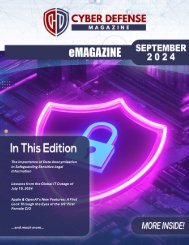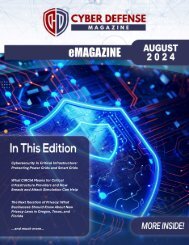Cyber Defense eMagazine February Edition for 2023
Cyber Defense eMagazine February Edition for 2023 #CDM #CYBERDEFENSEMAG @CyberDefenseMag by @Miliefsky a world-renowned cyber security expert and the Publisher of Cyber Defense Magazine as part of the Cyber Defense Media Group as well as Yan Ross, Editor-in-Chief and many more writers, partners and supporters who make this an awesome publication! Thank you all and to our readers! OSINT ROCKS! #CDM #CDMG #OSINT #CYBERSECURITY #INFOSEC #BEST #PRACTICES #TIPS #TECHNIQUES
Cyber Defense eMagazine February Edition for 2023 #CDM #CYBERDEFENSEMAG @CyberDefenseMag by @Miliefsky a world-renowned cyber security expert and the Publisher of Cyber Defense Magazine as part of the Cyber Defense Media Group as well as Yan Ross, Editor-in-Chief and many more writers, partners and supporters who make this an awesome publication! Thank you all and to our readers! OSINT ROCKS! #CDM #CDMG #OSINT #CYBERSECURITY #INFOSEC #BEST #PRACTICES #TIPS #TECHNIQUES
You also want an ePaper? Increase the reach of your titles
YUMPU automatically turns print PDFs into web optimized ePapers that Google loves.
Step 1: take inventory.<br />
First and <strong>for</strong>emost, organizations need to have full visibility into all the data and assets they hold. One of<br />
the defining hallmarks of CPRA/CCPA is that it gives consumers the “right to know” what data is collected<br />
and what it’s being used <strong>for</strong>. And as the organization, it is your responsibility to ensure full transparency.<br />
I’m a firm believer that you cannot possibly protect what you can’t see. As companies continue to migrate<br />
entirely to the cloud, their exposed data and resources need to first be identified be<strong>for</strong>e they can ever be<br />
properly protected. Further, you need to understand who has access to that data, and this isn’t just<br />
physical users. Often, malicious activity is done not by individual users with direct access, but by any<br />
user who can trigger a cloud component to run activities <strong>for</strong> them. This is a blind spot security teams<br />
should always be aware of – what components have access to the crown jewels within my organization?<br />
Is there an open door because of mismanaged Identity and Access Management (IAM) policies that<br />
potentially make the organization noncompliant? The new CPRA/CCPA regulations introduced two key<br />
amendments that will make IAM even more critical in organizations – the “right to correct” and the “right<br />
to limit use and disclosure” of sensitive in<strong>for</strong>mation. Taking full inventory of what you hold is the first step<br />
to remaining compliant.<br />
Step 2: don’t neglect encryption.<br />
Once data is identified, there are a few best practices all companies should employ to protect this<br />
sensitive in<strong>for</strong>mation. For one, don’t overlook encryption, which is probably the most useful yet simplest<br />
technology to use. It is incorporated into almost every cloud and SaaS service that you have, so there’s<br />
no excuse <strong>for</strong> organizations not to take advantage of it! One mistake I’ve encountered as both a leader<br />
of Research and Development (R&D) teams and as an entrepreneur working with these teams, is the<br />
tendency to disregard pockets of data as insignificant. But as we see with CPRA/CCPA, there is no data<br />
that is not at risk of slipping through the cracks which could ultimately result in hefty fines. For example,<br />
teams might spend time testing a data set and then proceed to delete it afterward, without realizing the<br />
sensitivity of the data at hand. Although it may seem small, this exposed data can open the door to more<br />
access, and in turn put your organization at risk. You must en<strong>for</strong>ce the encryption policy at all times.<br />
Remember, as the IT security team, it is your responsibility to control the data flowing in and out of your<br />
organization. Encryption allows you a stronger hold over your data security in the cloud.<br />
Step 3: maintain a least privileged state.<br />
Cloud applications differ from legacy applications in that they are dynamic and change frequently. You<br />
cannot employ a “set and <strong>for</strong>get” approach to the identity and access management of data in the cloud.<br />
Rather, you need to ensure your security permissions are changing and adapting to the application<br />
throughout time. Do you have the technology and processes in place that can alert you of any<br />
unnecessary entities that can read your sensitive data? By constantly maintaining a least-privileged state,<br />
you will reduce any exposed attack surfaces and limit the potential blast radius of a breach. Every<br />
organization is different, depending on a variety of factors, including company size, processes and the<br />
type of data they hold. Finding that perfect balance in granting privileges is key, especially where<br />
CPRA/CCPA is concerned. For example, having too few permissions could result in denied actions, but<br />
<strong>Cyber</strong> <strong>Defense</strong> <strong>eMagazine</strong> – <strong>February</strong> <strong>2023</strong> <strong>Edition</strong> 70<br />
Copyright © <strong>2023</strong>, <strong>Cyber</strong> <strong>Defense</strong> Magazine. All rights reserved worldwide.


















